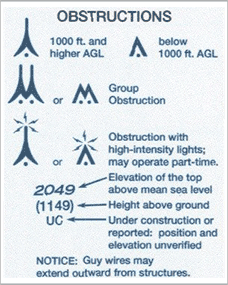| The following stories from the November 14, 2008, edition of AOPA ePilot were provided to AOPA members who expressed an interest in the particular subject areas. Any AOPA member can receive information tailored to their areas of interest by updating their preferences online. TRAINING TIPsObstructions old and new
Obstructions—especially those associated with construction projects—may even come and go on a temporary basis. Some of those are very close to airports, as this recent notice to airmen about Maine's Lincoln Regional (LRG) advised pilots: BGR 08/031 LRG OBST CRANE UNKN (225 AGL) 2600 E RWY 35. Note also the presence of a permanent obstruction northeast of the airport on the sectional chart excerpt that accompanies LRG's listing in AOPA's Airport Directory Online .
Review chart depictions of obstructions and note that their appearance depends on a number of factors, including their height above ground, whether they are single or group obstructions, and whether they are lighted or otherwise marked. In congested areas, only the highest obstructions may be depicted. Check the illustrations and explanations in the Aeronautical Chart User's Guide .
Obstruction lighting and marking may follow one of a variety of schemes, as explained in Chapter 2 of the Aeronautical Information Manual . The chapter describes five typical combinations of lighting and obstruction paint schemes, with lighting capable of being set at different intensities for day and nighttime conditions. (When lighting is out of service, a notam advises pilots of the hazard.)
Two items that appeared in the January 2008 AOPA Pilot demonstrate how hazards—including a too-tall building and a radio tower being reconstructed after being hit by an aircraft—may appear or reappear in locations posing dangers to pilots. This emphasizes the need all pilots have to stay informed about obstructions to air navigation, and to monitor the changes that inevitably, and sometimes rapidly, occur. TRAINING PRODUCTSSporty's 'Garmin 696/695 Checkout' DVDIf you've plunked down the money for Garmin's new GPSMAP 696, you'll want to know all of the box's capabilities before you put it to work. AOPA Pilot Senior Editor Dave Hirschman put the GPSMAP 696 through its paces for a review in the December 2008 issue, and he blogged his first impressions. Sporty's has released Garmin 696/695 Checkout, the latest in its "What You Should Know" series. The program promises to teach users how to navigate the main pages, learn handy shortcuts to manage screen brightness and extend battery life, and how to use flight plans and XM satellite weather to make strategic weather decisions in flight, for starters. The program sells for $29.95 and is available in DVD format or as an instant download from Sporty's Web site. Order online or call 800/SPORTYS. Note: Products listed have not been evaluated by ePilot editors unless otherwise noted. AOPA assumes no responsibility for products or services listed or for claims or actions by manufacturers or vendors. FINAL EXAMQuestion: It was very cold this morning, and I noticed some frost on my airplane. Am I allowed to fly with frost or ice on the airplane?
Answer: Ice, snow, and frost affect more than the wing's ability to generate lift. The additional weight can exceed your maximum takeoff weight and render your aircraft uncontrollable. While the regulations do not specifically prohibit Part 91 operators from flying with wing contamination, it could be viewed as a careless and reckless operation under FAR 91.13. Part 121 and Part 135 operators are strictly prohibited from flying with any wing contamination. For more information about the effects of ice and snow on your aircraft, read this article from AOPA Flight Training or review the AOPA Air Safety Foundation's information on aircraft icing.
Got a question for our technical services staff? E-mail to [email protected] or call the Pilot Information Center, 800/872-2672. Don't forget the online archive of "Final Exam" questions and answers, searchable by keyword or topic. |
 The Nov. 7, 2008,
The Nov. 7, 2008, 

